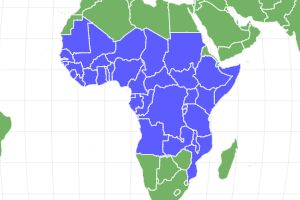Secretes up to 4g of musk every week!
Advertisement
African Civet Scientific Classification
- Kingdom
- Animalia
- Phylum
- Chordata
- Class
- Mammalia
- Order
- Carnivora
- Family
- Viverridae
- Genus
- Civettictis
- Scientific Name
- Civettictis civetta
Read our Complete Guide to Classification of Animals.
African Civet Conservation Status
African Civet Facts
- Prey
- Rodents, Snakes, Frogs
- Name Of Young
- Pup
- Group Behavior
- Solitary
- Fun Fact
- Secretes up to 4g of musk every week!
- Estimated Population Size
- Abundant
- Biggest Threat
- Habitat loss
- Most Distinctive Feature
- Black band around their eyes
- Gestation Period
- 60 - 70 days
- Habitat
- Tropical rainforest
- Predators
- Lions, Snakes, Leopards
- Diet
- Omnivore
- Average Litter Size
- 3
- Lifestyle
- Nocturnal
- Common Name
- African Civet
- Number Of Species
- 1
- Location
- across sub-Saharan Africa
- Slogan
- Secretes up to 4g of musk every week!
- Group
- Mammal
African Civet Physical Characteristics
- Color
- Brown
- Grey
- Yellow
- Black
- White
- Tan
- Skin Type
- Fur
- Lifespan
- 15 - 20 years
- Weight
- 1.4kg - 4.5kg (3lbs - 10lbs)
- Height
- 43cm - 71cm (17in - 28in)
- Age of Sexual Maturity
- 11 - 12 months
- Age of Weaning
- 8 - 10 weeks
View all of the African Civet images!
Classification And Evolution
The African Civet is a large species of civet found in savannahs and forests across sub-Saharan Africa. It is the only member in its genus and is considered to be the largest civet-like animal on the African continent. Regardless of their cat-like appearance, African Civets are not felines but are in fact, more closely related to other small carnivores including weasels and mongooses. Best known for the musk that it secretes to mark its territory (called Civetone), which has been used in the production of perfumes for centuries. This mammal’s striking black and white markings make it easy to identify.
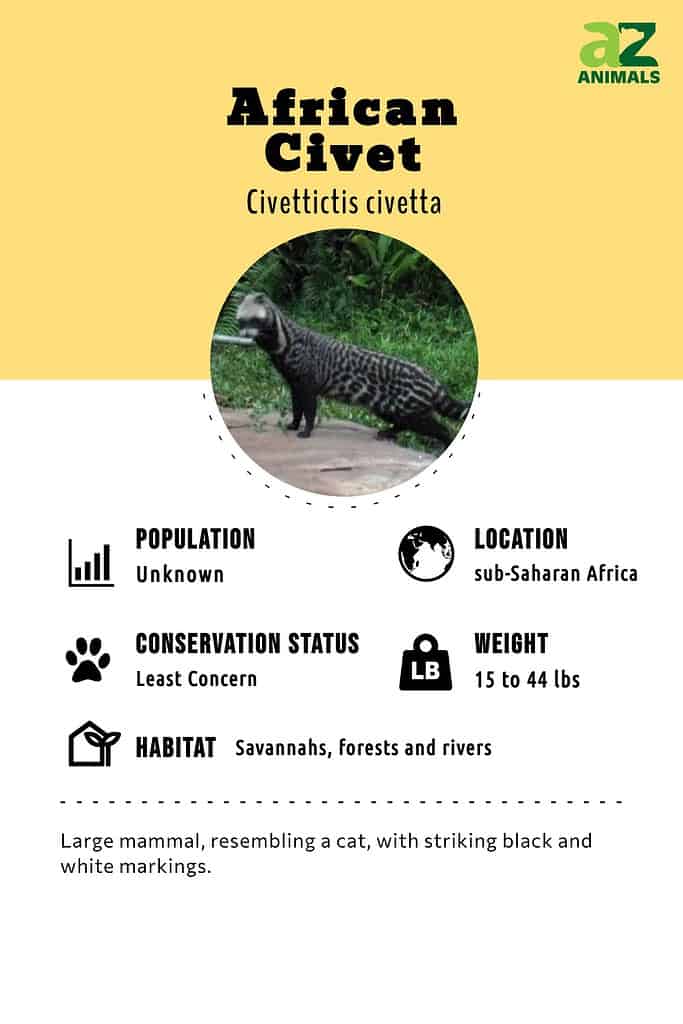
Evolution And Origin
It is believed that the African Civet is a descendant of the Viverra genus. Although closely related, they most likely diverged over 12 million years ago. Due to several distinct differences between the two, it was determined that this genus was a new species and is currently, as a result of the significant amount of contrasting characteristics, the only member of the genus Civettictis.
Anatomy And Appearance

An African Civet is distinct because of its black and white markings on their fur.
©Николай Усик / http://paradoxusik.livejournal.com/, CC BY-SA 3.0, via Wikimedia Commons – License
One of the African Civet’s most distinctive features is the black and white markings on their fur and grey face. Along with the black band around their eyes, their coloring gives these animals a raccoon-like appearance. The similarity is only intensified by the fact that the African Civet’s rear legs are quite a bit longer than the front legs, making its stance very different from that of the mongoose. The average adult African Civet has a body length of around 27.55 inches with a tail of nearly the same length, and paws that each have five digits with non-retractable claws to enable it to move through the trees easily.
Distribution And Habitat
The African Civet is found in numerous habitats on the African continent, with its range extending coast to coast, and can also be found in river systems in Chad, Mali, and Niger, all located in sub-Saharan Africa. They are most commonly found in jungles and tropical forests and areas where there is plenty of heavy vegetation to provide both concealment and animals that the African Civets lives on. These mammals are rarely found in arid regions and always must be in an area that has a good water source, although it is not out of the ordinary for them to be found along rivers that lead into more arid environments. In addition to being capable swimmers, they also often spend their time hunting and resting in trees as well as on the ground.
Behavior And Lifestyle
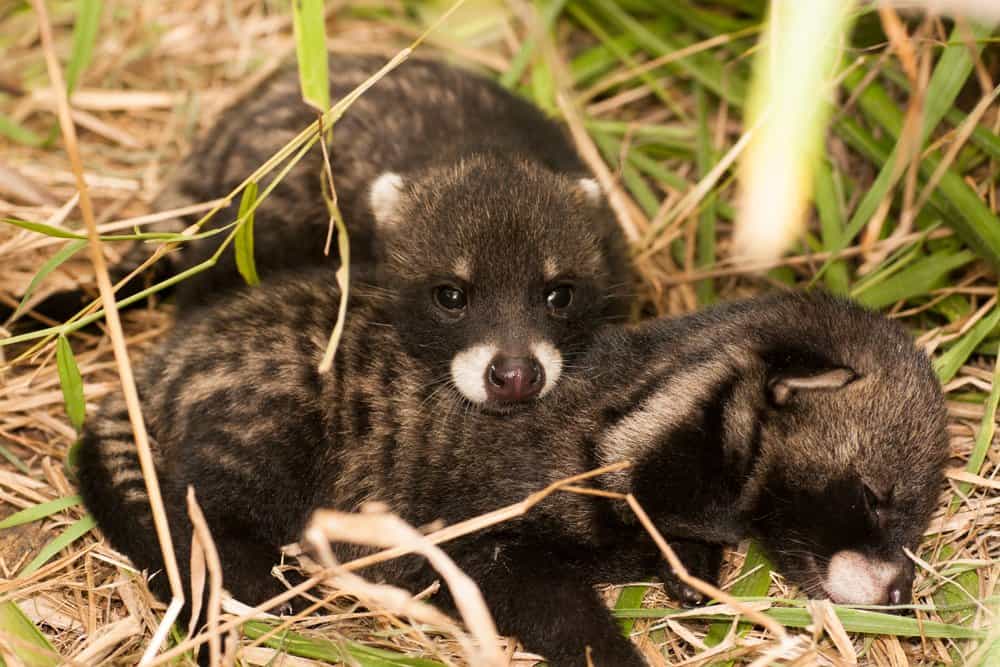
The African Civet is highly territorial and during mating season, has been known to gather in large groups.
©Mark Sheridan-Johnson/Shutterstock.com
Lone animals that only come out during the dark to hunt and catch food, these nocturnal animals are mainly tree-dwelling and spend most of the day resting in the safety of the trees. African Civets tend to be most active at twilight, just after sunset, but tend to hunt in areas that still provide plenty of cover. Despite being altogether solitary creatures, the African Civet has been known to gather in larger groups, up to 15 members, especially during mating season. Highly territorial animals, they will mark their boundaries with the scent released by their perineal glands.
Reproduction And Life Cycles
The only time African Civets seem to be seen together is when they are mating. The female generally gives birth to up to 4 young after a gestation period that lasts for a couple of months and nests in an underground burrow that has been dug by another animal in order to safely raise her young. Unlike many of their carnivorous relatives, civet babies are usually born quite mobile and with their fur. The babies are nursed by their mothers until they are strong enough to fend for themselves. African Civets can live for up to 20 years, although many rarely get to be this old.
Diet And Prey
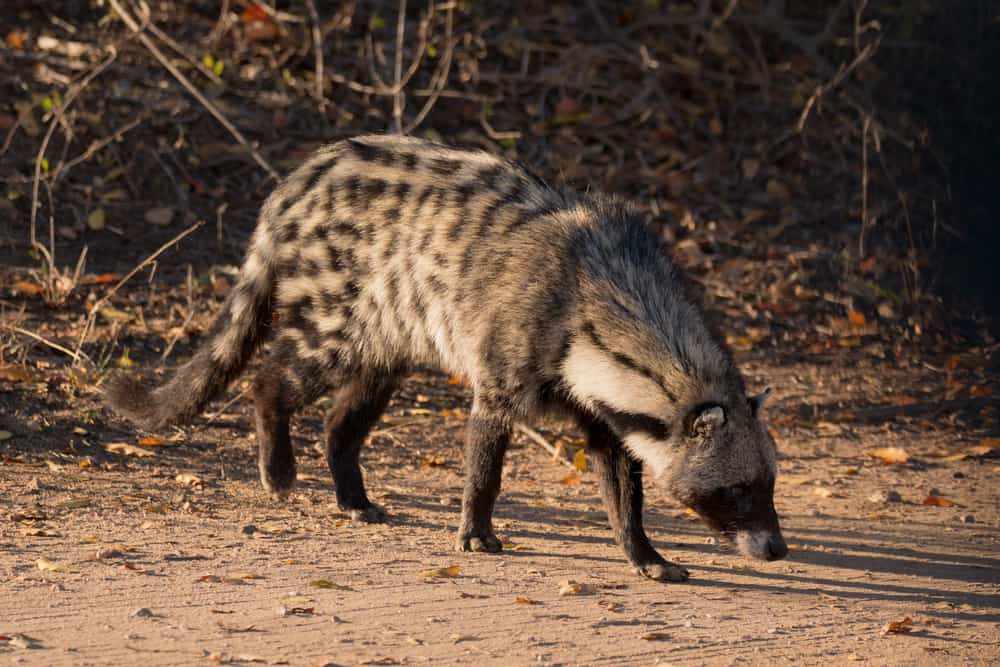
The civet has a varied diet consisting of both meat and plants.
©francesco de marco/Shutterstock.com
Despite the fact that the African Civet is a carnivorous mammal, it has a very varied diet that consists of both animal and plant matter. Small animals such as frogs, rodents, lizards, and snakes make up the majority of the African Civet’s diet, along with berries, insects, fallen fruits, and anything that it finds on the forest floor. Rather than use its paws, the African Civet primarily uses its teeth and mouth to gather food and this way of eating means that it can use its 40 sharp teeth effectively to break down its catch while its strong jaw makes it harder for its meal to try and escape.
Predators And Threats
Despite being a covert yet relatively merciless predator, the African Civet is in fact preyed upon by numerous predators within their natural environment. Large predatory cats are the most common hunters of the African Civet including leopards and lions, as well as large snakes and crocodiles. African Civet populations are also under threat from both loss of habitat and deforestation and have been vulnerable to trophy hunters in the past, across Africa. One of the biggest threats to the African Civet is the demand for their musk.
Interesting Facts And Features
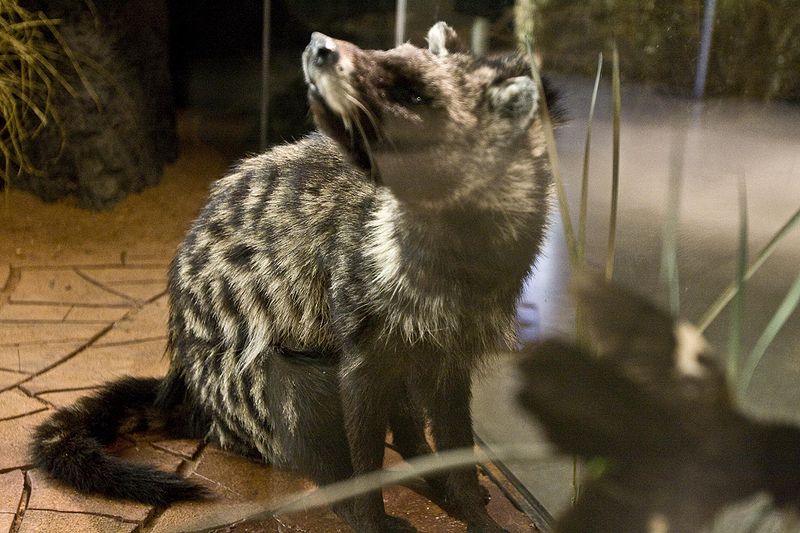
African Civet musk glands were an ingredient in some of the most expensive perfumes in the world.
©Wikipedia Loves Art participant “assignment_houston_one”, CC BY 2.5, via Wikimedia Commons – License
The glands close to the African Civet’s reproductive organs secrete a musk that has been collected by humans for centuries. The smell is said to be quite offensive to people when it is in a concentrated form but much more pleasant once it’s diluted. This is the scent that became one of the ingredients in some of the most expensive perfumes in the world and led to the African Civet becoming a well-known animal. African Civets are known to carry rabies disease, which is contracted through contact with an infected animal.
Relationship With Humans
Each African Civet secretes up to 4g of musk on a weekly basis, which is ordinarily garnered from them in the wild. However, it is not unknown to capture and keep African Civets for their musk, and is thought of as an incredibly cruel industry. Today, there are very few perfumes that still contain actual musk from their glands as there are many scents today that are easily artificially reproduced. Although it is not yet an endangered animal, its population has also been severely affected by human hunters, who like to add their fur and skin to the trophy cabinet.
Conservation Status And Life Today

An African Civet is not currently in danger of becoming extinct.
©Cliff (cliff1066™) / CC BY 2.0, Flickr – License
Today, the African Civet is under threat from deforestation and therefore in danger of losing much of its natural habitat. There is such an extensive case of deforestation in the area due to logging and clearing of the land. The African Civet is currently classed as being the Least Concern, which means that there is little threat at the moment that the African Civet will become extinct in the near future.
View all 194 animals that start with AAfrican Civet FAQs (Frequently Asked Questions)
Are African Civets herbivores, carnivores, or omnivores?
African Civets are Omnivores, meaning they eat both plants and other animals.
What Kingdom do African Civets belong to?
African Civets belong to the Kingdom Animalia.
What phylum to African Civets belong to?
African Civets belong to the phylum Chordata.
What family do African Civets belong to?
African Civets belong to the family Viverridae.
What order do African Civets belong to?
African Civets belong to the order Carnivora.
What is the biggest threat to the African Civet?
The biggest threat to the African Civet is habitat loss.
How to say African Civet in ...
Thank you for reading! Have some feedback for us? Contact the AZ Animals editorial team.
Sources
- David Burnie, Dorling Kindersley (2011) Animal, The Definitive Visual Guide To The World's Wildlife
- Tom Jackson, Lorenz Books (2007) The World Encyclopedia Of Animals
- David Burnie, Kingfisher (2011) The Kingfisher Animal Encyclopedia
- Richard Mackay, University of California Press (2009) The Atlas Of Endangered Species
- David Burnie, Dorling Kindersley (2008) Illustrated Encyclopedia Of Animals
- Dorling Kindersley (2006) Dorling Kindersley Encyclopedia Of Animals
- David W. Macdonald, Oxford University Press (2010) The Encyclopedia Of Mammals
- About African Civets, Available here: http://www.robinsonlibrary.com/science/zoology/mammals/carnivora/civet.htm
- Civet Scent Glands, Available here: http://thewebsiteofeverything.com/animals/mammals/Carnivora/Viverridae/Civettictis/Civettictis-civetta.html
- African Civet Benhaviour, Available here: http://www.wildlifesafari.info/african_civet.html
- The African Civet, Available here: http://www.predatorconservation.com/civet.htm

